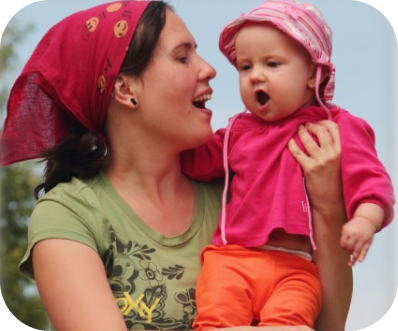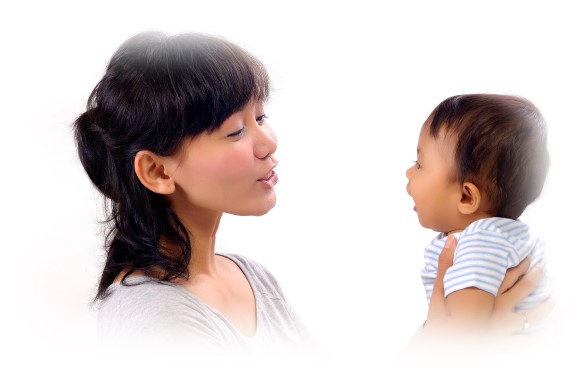MUSICAL
CONNECTIONS
Interactive
3 months to 12 months

December 8, 2023
Interactive musical connections for a baby will start around their third month and extend throughout early childhood and beyond. A baby in their first year begins to express their musical connections by producing sounds or movements in multiple ways.
A baby may show these following behaviors when interacting with music. (partial list)
- be an engaged listener who responds by changing their mood.ex. during a transition period -- from one routine to another -- their emotions shift
- be an active participant who uses their voice to create speech sounds and other noises ex. vocally produces --babbling sounds, and/or parts of words or words
- be an active participant who uses their fine motor skills ex. wiggles fingers, shakes objects held in hands or claps
- be an active participant who uses their gross motor skills ex. sits to -- bang objects together or make noises/sounds with a musical instrument
It’s exciting to know that learning about music helps a baby to understand about rhythm, rhyme, patterns and MORE! Music time is a positive way to enhance a baby’s communication skills. It’s an important link to language learning and their literacy success.
A young baby does change significantly during the last nine months of their first year. How and when they’ll become actively involved with music depends on each baby’s own developmental growth. Body movements, vocal sounds, facial expressions, and instrumental music-making (sounds/noises) are all part of music time. The box below presents suggested timelines for some milestones/skills that a baby may use when interacting with music.
Musical Connections:
Milestones and Skills

- rocks back& forth
- begins to sit up
- grabs things with hands
- turns head towards sounds
- facial expressions
- giggles & laughs & smiles
- babbling
- kicks legs
- makes squealing noises
- sways and bounces
- dance—(baby bop)
- sits without help
- holds objects longer
- clapping
- open hand pointing
- copies movements
- imitates sounds & few words
- follows simple directions
Babies certainly do develop these skills/milestones at their own rate. Each baby will learn and grow at a different pace. They will require loving support to guide them towards everyday successes. Individuality is the spice of life!
Familiar Songs & Nursery Rhymes & Lullabies
There are an abundance of songs to choose from for a baby’s listening enjoyment and participation. Many nursery rhymes, songs and poems that have repetitive verses and/or actions are well received by the baby. An all-time favorite is the tune, Twinkle, Twinkle, Little Star.
This familiar nursery rhyme may be sung as a lullaby, softly and at a slow pace without the hand motions before nap or bedtime. Or just declare it to be the perfect song for the moment and belt it out. The song goes quickly, remember that repetition of any song helps the brain acquire language faster--- SO give it another go! Sing it again and again, - the baby brain says, “Yippee!”.
Sharing this song with or without the hand movements is an interactive experience for the baby and parent. In the beginning the baby starts off as a watcher and listener. Once the baby is older, and their finger/hand coordination has improved – clapping might appear. Later-on, they’ll try doing a few of the motions. Oh, and happy baby babbling sounds could start any time, too!
Twinkle, Twinkle, Little Star
- Twinkle, twinkle, little star,
- How I wonder what you are!
- Up above the world so high,
- Like a diamond in the sky.
- Twinkle, twinkle, little star,
- How I wonder what you are!
Twinkle, Twinkle, Little Star Actions
-
1st line arms up, each hand at eye-level beside
face - fingers pointing out to represent stars-
bring fingers together in center of hand,
touch tips together & back out
(twinkling 3 times) - 2nd line continue twinkling-shrug shoulders with facial expression of wonderment
- 3rd line twinkling hands-move higher above head as if going up to the sky
- 4th line keep twinkling high up above head
- 5th line slowly bring twinkling hands down to face level
- 6th line twinkle hands-shrug-and stop

Enjoy using this song with your baby.First sing it without the motions, later add them. Your baby will be delighted with your lively body movements.It’s a performance that will become an all time favorite!
Kylene
P.S. Coming attractions —
MORE songs future posts!
“Music can facilitate speech because it uses areas of the brain that are involved in communication.
Rhythm can aid in vocal production by organizing the mechanisms involved in speech.“
Resources & References
CDC- Center for Disease Control and Prevention, (2023), Important Milestones Your Child by One Year https://www.cdc.gov/ncbddd/actearly/milestones/milestones-1yr.html
Mercy Top News, Learning Language Through Music: How Music Helps Baby Brain Development, https://www.mercy.net/service/newborn-baby-care/music-brain-development/#:
WebMD, (2022), Baby Development: Your 6th Month Old, https://www.webmd.com/parenting/baby/baby-development-6-month-old
Early Literacy Learning
